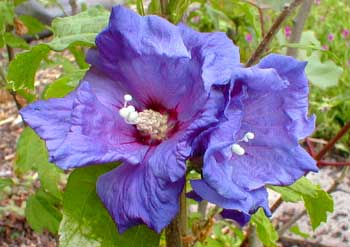
'Blue Bird' Hibiscus
or Rose of Sharon;
aka 'Oiseau Bleu'
Shrub Althaea
Hibiscus syriacus 'Blue Bird' (often listed improperly as one word as 'Bluebird'), also known by its French name 'Oiseau Bleu,' is a popular heirloom shrub, possibly the most commonly gardened variety of Rose of Sharon Hibiscus.
It produces a nearly true-blue pale to medium-dark blue flower, only slightly edging into lavender. It is navy blue & magenta at the bottom of the throat with large white to creamy white to pale yellow stamins.
The moderate growth rate is not the swiftest of H. syriacus cultivars. It reaches seven to ten feet tall & nearly as wide, though it can & probably should be kept pruned to a smaller size or narrower width. It naturally takes on an upright & fountaining vase-shape, but alternatively can be trained as an upright miniature tree by preserving only a central trunk.
We also have an 'Aphrodite' Rose of Sharon which is sterile so will not spread, but 'Blue Bird' is fully fertile. It can self-seed rather too much if the seedpods are not removed at some point after autumn leaf-fall & before the pods burst open. Seed capsules can be decorative for winter, but leaving them pretty much guarantees seedlings will erupt in the garden.
Any seedlings that are not weeded out of the garden their first year will be large enough to bloom their second year, but are rarely the precise color of the parent. True 'Blue Bird' specimens have generally been propogated by cuttings & grafts, because the result of propogation from seeds is so very uneven, producing every shade of blue, violet, or mauve. For the home gardener wanting to propogate a second specimen with the same flower, it is easily rooted from summer cuttings, assisted by rooting hormone available at any good nursery or garden center.
Some nursery offerings, however, are seed-grown. Because seedlings are so unpredictable, the exact appearance of flowers on shrubs sold as 'Blue Bird' can be varied from specimen to specimen. Such unpredictability is not necessarily a bad thing, for the throat can be navy blue, magenta, red, or with two bands of color, & such variation is only found among cheaper seed-grown stocks. But a gardener needs to choose it in flower to be sure of getting a specimen that has retained the best blue over the greater portion of the petals, for some seedlings will have a washed-out inferior coloration.
We obtained ours during an autumn's end blow-out plant sale — a largish $30 plant was marked down to a mere $7 — but fortunately it had a couple lingering flowers on its branches, so we had no worry that it might pove to be less than splendid color.
A choice 'Blue Bird' seedling gave rise to a more uniform clone called 'Blue Satin' & that would be more easily trusted to have the best blue even if purchased out of season without flowers on it to judge.
'Blue Bird' is one of the most beautiful of all Rose of Sharon cultivars, its blue blossoms being large & numerous, standing out wonderfully amidst the wrinkly green foliage. It releafs late in spring, but holds its leaves until the end of autumn. May's new foliage starts yellow aging to green. If it is not a good green by mid-June, there may be an iron deficiency in the soil, easily remedied by fertilizing with chelated iron.
It flowers most splendidly in July & August. Some flowering occurs as late as September's end. It is not at all improbable (in our mild zone) that it will provide one final blue flower in mid-November even though the leaves are already long gone!
'Blue Bird' transplants without much stress, is not fussy about soil conditions, & is hardy in zones five through eight. It requires full sun & does well in droughty conditions. In zone 8 it will thrive in partial shade, but blooms will be less numerous.
It prefers the hottest spot in the garden with the most sun. In chillier climates some of the stems will be killed by winter freezes but with hard pruning just before spring, it will grow back perfectly & come summer will bloom as powerfully as ever.
Late winter or early spring pruning will keep it from getting rangy, & encourage a central few branches to bulk up with nice woody form. A hard pruning in late winter will result in fewer but much larger five-inch-wide flowers, whereas a moderate pruning results in smaller flowers but in greater numbers.
Because 'Blue Bird' is comparatively slow in its growth rate, it remains compact without as much pruning as most varieties of H. syriacus, but failure to prune annually results in an increasingly leggy shrub that blooms less & less well, because it flowers exclusively on new wood. As a conservative average, a full one-third of the previous year's growth should be trimmed out each January or March well before new growth begins, but more certainly can be trimmed.
A Meditation Upon
the Mythology of the Rose of Sharon